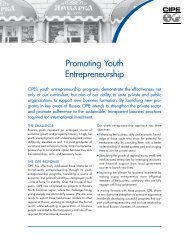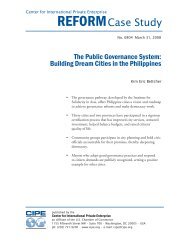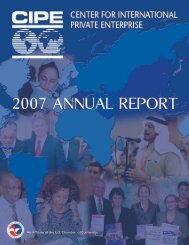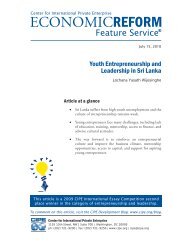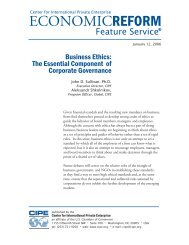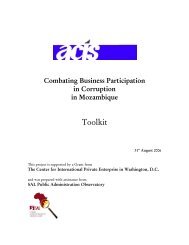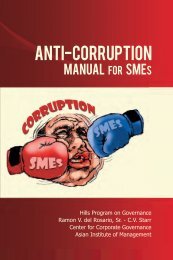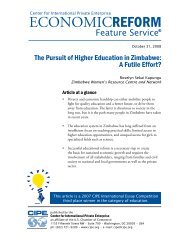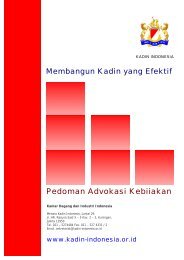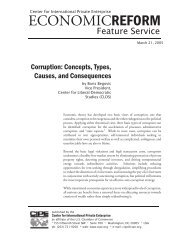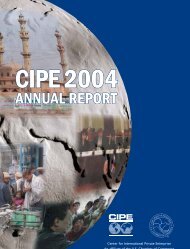REDUCING CORRUPTION A Report on Two Anti-Corruption Projects
REDUCING CORRUPTION A Report on Two Anti-Corruption Projects
REDUCING CORRUPTION A Report on Two Anti-Corruption Projects
Create successful ePaper yourself
Turn your PDF publications into a flip-book with our unique Google optimized e-Paper software.
Evaluati<strong>on</strong> <str<strong>on</strong>g>Report</str<strong>on</strong>g>Reducing Corrupti<strong>on</strong>I. BRAZILBackgroundIn late 1970’s early 1980s hyperinflati<strong>on</strong> began undermining the Brazilian ec<strong>on</strong>omy whose macroec<strong>on</strong>omicperformance had been impressive since the 1950’s. Driven to a great extent by excessive statespending <strong>on</strong> government programs, bureaucracy and state enterprises, inflati<strong>on</strong> was addressed fr<strong>on</strong>tally bythe government of President Cardoso beginning in 1993 with “Plan Real”. Privatizati<strong>on</strong> of a number ofkey state enterprises has helped cut spending and significantly reduce the size of the foreign debt. This,as well as enhanced fiscal discipline, has generated a sharp reducti<strong>on</strong> in inflati<strong>on</strong>.Late 1998 shocks sparked by the financial market collapse in Russia have led to sharp outflows ofinvestment in Brazil deflating the currency and feeding a recessi<strong>on</strong>ary trend that included highunemployment. The ec<strong>on</strong>omy over the last few m<strong>on</strong>ths has recovered more quickly than many expectedand the state has managed the immediate fiscal crunch. But clearly more hardship is in the forecast. Mostpolls rate unemployment the primary public c<strong>on</strong>cern.Observers agree that there is very little likelihood of any slippage back to renewed levels of stateownership, spending and interventi<strong>on</strong>. But there remains some questi<strong>on</strong> whether <strong>on</strong>going sec<strong>on</strong>dgenerati<strong>on</strong> ec<strong>on</strong>omic and instituti<strong>on</strong>al reform will be energetically embraced to modernize the state thatstill is large and costly. While the first stage of reforms have helped Brazil overcome hyperinflati<strong>on</strong>, thenati<strong>on</strong>’s competitive standing still remains weak even as compared with neighbors.After re-electi<strong>on</strong> late last year then devaluati<strong>on</strong> of the currency, President Cardoso has been beset bypolitical troubles. His popularity ratings are at record lows, his cabinet is in some disarray and key taxreforms measures are floundering as the four party coaliti<strong>on</strong> that supported him in C<strong>on</strong>gress has begun tosag. On the other hand a center-right majority in C<strong>on</strong>gress is for the first time experimenting with takingthe reform initiative. Special legislative commissi<strong>on</strong>s are preparing to present tax and judicial reformproposals sometime this year. It is uncertain whether the President will pay these initiatives any heed.Based <strong>on</strong> a loop-hole in the 1988 c<strong>on</strong>stituti<strong>on</strong>, the Executive has managed to mostly manhandle C<strong>on</strong>gress(even <strong>on</strong>e that has for the most part supported his reform agenda) by utilizing provisi<strong>on</strong>al executivemeasures that are renewable m<strong>on</strong>thly without c<strong>on</strong>gressi<strong>on</strong>al vote. This means that the central questi<strong>on</strong> inBrazil is whether further instituti<strong>on</strong>al reform is <strong>on</strong> the President’s agenda for this year. By spring nextyear the campaigning for late 2000 municipal electi<strong>on</strong>s will supercede reform c<strong>on</strong>siderati<strong>on</strong>s.The President could let the reform process drift leaving the Brazilian state in limbo betweenmodern/global and costly/interventi<strong>on</strong>ist. The fundamental instituti<strong>on</strong>al framework for steady growth,str<strong>on</strong>g and sustainable investment, low unemployment and decent services is not yet in place.The c<strong>on</strong>stituency that has pressed for reform is also less than vigorous and uniform. Even the mostavid advocates of reform have benefited richly from state subsidies, protecti<strong>on</strong> and interventi<strong>on</strong>s over theyears. The electoral system set up during the military years weighs heavily toward the more feudal norththat for the time being is pro- liberalizati<strong>on</strong> but not squarely pro-modernizati<strong>on</strong>. This all suggests thatmost Brazilian stakeholders who have supported privatizati<strong>on</strong> and reform efforts have d<strong>on</strong>e so for shortand mid term returns to overcome the inflati<strong>on</strong> crisis. The support for l<strong>on</strong>g term, integrated reform is noteasy to come by. This mirrors a regi<strong>on</strong>al trend – reforms initiated during crisis have stalled when theworst of the crisis is overcome.Various private sector groups have coined the slogan “Custo Brasil” to mobilize <strong>on</strong>going support forliberalizati<strong>on</strong> to reduce transacti<strong>on</strong> costs that make Brazilian goods less competitive <strong>on</strong> the global market.This tact has proved effective in focusing reform and liberalizati<strong>on</strong> efforts <strong>on</strong> benefits to Brazil’s2



